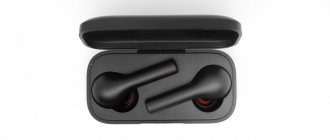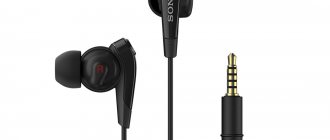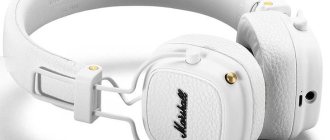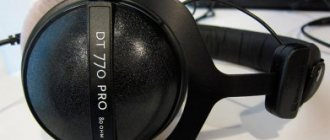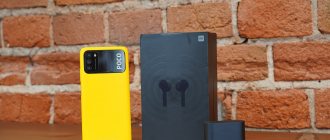Last year we introduced you to the iconic model of full-size headphones Sony MDR-1R. The entire editorial team liked them, but we couldn’t find any downsides. The MDR-1A is a kind of update to the MDR-1R - although it’s hard for us to imagine what could have been improved, the Japanese engineers did a really good job on the model. But we’ll tell you what came out of it in the article.
Sony MDR-1A Headphones, headsets on
Notify when on sale
Contents of delivery
I remember the delight I felt when I saw the Sony MDR-1R box - it was too premium. No matter how paradoxical it may sound, the packaging of the MDR-1A personally did not impress me as much as the packaging of its predecessor.
Having removed the cardboard casing, we are presented with a box, inside of which everything is the same as in the configuration of last year’s hero: a case, two 1.2-meter cables (one for smartphones) and documentation. Special thanks to the developers for such a high-quality case that does an excellent job of preserving the headphones.
Appearance, materials, assembly
The facelift is not immediately noticeable, but there are changes. The first is a slightly different structure of the metal coating on the bowls; previously it was matte, but now it’s something like an imitation of leather. The V-shaped fastenings of the bowls and the cable connector have also changed - now it has a bronze tip. Yes, there are no supernatural changes, but this is not required, because why change something that already looks great?
The materials are absolutely identical to the MDR-1R and are represented by His Majesty metal at the base of the arc and bowls, Madame eco-leather in the upholstery of the ear pads and headband, as well as Mr. plastic in the rest of the device. The assembly is similar to its predecessor and there is nothing to complain about - it’s like a Mercedes, only in the world of headphones.
Detailed report
Frequency response and impedance Sony 1R
| Frequency response and impedance | |
| general channel | |
| Sensitivity average in the range 100 Hz 10 kHz, dB/V | 125,5 |
| Frequency response unevenness in the range 100 Hz 10 kHz, dB | -4,0, +4,4 |
| Sensitivity at 500 Hz at 1 V, dB | 122,4 |
| Sensitivity at 500 Hz at 1 mW, dB | 107,5 |
| Sensitivity at 1000 Hz at 1 V, dB | 124,9 |
| Sensitivity at 1000 Hz at 1 mW, dB | 109,7 |
| Average resistance in the range 40 Hz 15 kHz, Ohm | 32,9 |
| Resistance at 500 Hz, Ohm | 32,6 |
| Resistance at 1000 Hz, Ohm | 30,1 |
| Maximum resistance in the range 40 Hz 15 kHz at 106.2 Hz, Ohm | 44,1 |
| Minimum resistance in the range 40 Hz 15 kHz at 5826.1 Hz, Ohm | 28,1 |
The amplitude-frequency response graph shows the frequency volume balance and the sensitivity of the headphones. If we produce a sine of a specific frequency by supplying it with a level of 1 V rms and fix the pressure level at the headphone output in a special chamber emulating an ear, then by going through the frequencies from 20 Hz to 20 kHz we will get the original frequency response graph. The frequency response graph in RAA is obtained through the reproduction and analysis of a special noise signal, followed by obtaining the impulse response in ARTA. The scale of the graph in RAA is similar to the scale of the RMAA graph for acoustic tests with a grid spacing of 6 dB and a range of 90 dB. A difference of 6 dB is equivalent to twice the signal level ratio. What is the frequency response of headphones in detail >>
The impedance graph shows the impedance of a headphone as a function of frequency. The resistance scale is presented on a logarithmic scale. The graph was obtained by playing and analyzing a special noise signal in LIMP (LIMP is included in the ARTA test package).
The sensitivity of the headphones is sufficient for portable use, where the lower limit is 110-115 dB. Unevenness of +-4 dB indicates a neutral frequency balance. A small dip in the 5-6 kHz region reduces the likelihood of sibilance occurring. An external amplifier for developing high volume is not relevant.
Frequency response of Sony 1R at 1 V supply
| Amplitude-frequency response of the right and left channels | ||
| channel | ||
| left | right | |
| Sensitivity average in the range 100 Hz 10 kHz, dB/V | 124,7 | 125,8 |
| Frequency response unevenness in the range 100 Hz 10 kHz, dB | -8,2, +4,6 | -4,2, +4,7 |
| Sensitivity at 500 Hz at 1 V, dB | 122,7 | 122,1 |
| Sensitivity at 500 Hz at 1 mW, dB | 107,8 | 107,2 |
| Sensitivity at 1000 Hz at 1 V, dB | 124,8 | 125,1 |
| Sensitivity at 1000 Hz at 1 mW, dB | 109,5 | 109,9 |
The smaller the discrepancy between the frequency response of the right and left channels, the clearer the panorama you can get. At the same time, other factors also influence the panorama.
The headphones have quite soft ear pads, which gives a discrepancy in fit, and on a stand with an artificial head you can observe noticeable differences in the region of the highest frequencies (which are not present on a flat stand), and on a flat stand some differences in the region of low frequencies, which in turn not on stand with artificial head.
Impedance Sony 1R
| Amplitude-frequency response of the right and left channels | ||
| channel | ||
| left | right | |
| Average resistance in the range 40 Hz 15 kHz, Ohm | 32,9 | 33,2 |
| Resistance at 500 Hz, Ohm | 32,6 | 32,9 |
| Resistance at 1000 Hz, Ohm | 30,1 | 30,7 |
| Maximum resistance in the range 40 Hz 15 kHz at 106.2/109.7 Hz, Ohm | 44,1 | 44,5 |
| Minimum resistance in the range 40 Hz 15 kHz at 5826.1/5642.4 Hz, Ohm | 28,1 | 28,6 |
The impedance graph shows the impedance of a headphone as a function of frequency. The resistance scale is presented on a logarithmic scale. The graph was obtained by playing and analyzing a special noise signal in LIMP (LIMP is included in the ARTA test package).
The minimum resistance is recorded at 5 kHz into 28 ohms, and the maximum at 106 Hz into 32 ohms. On the box the resistance is listed as 24 ohms. In general, it is customary to operate with standard numbers and between 24 and 32 Ohms the manufacturer used 24 Ohms, which was probably chosen for marketing reasons.
Due to the fact that the impedance is still lower than most on-ear headphones with an impedance of 50 ohms, some of the distortion in the sound can come from a headphone amplifier (especially an inexpensive device), and therefore using an external amplifier designed for a low impedance load may be useful.
Sony 1R Frequency Response - Difference Between Right and Left Channel
| The difference in the amplitudes of the frequency characteristics of the right and left channels | ||
| Standard deviation between channels in the range 40 Hz 15 kHz, dB | 1,3 | |
| Standard deviation between channels in the low-frequency range 40 Hz 200Hz, dB | 1,1 | |
| Standard deviation between channels in the mid-frequency range 200 Hz 2 kHz, dB | 1,6 | |
| Standard deviation between channels in the high-frequency range 2 kHz 15 kHz, dB | 1,0 | |
The smaller the discrepancy between the frequency response of the right and left channels, the clearer the panorama you can get. At the same time, other factors also influence the panorama. For full-size and overhead models, comparative data is calculated from the SF stand
The main spread of values is caused not so much by the difference in the parameters of the capsules, but by the soft ear pads, due to which the fit of the headphones differed when installed on measuring stands.
Frequency response of Sony 1R depending on the matching of impedance and output impedance of the amplifier with typical values with constant internal resistance
| Frequency response depending on the amplifier output impedance | ||
| Frequency response deviation in the range 20 Hz - 20000 Hz with an internal amplifier resistance of 10 Ohms, dB | 0,9 | |
| Frequency response deviation in the range 20 Hz - 20000 Hz with an internal amplifier resistance of 20 Ohms, dB | 1,5 | |
| Frequency response deviation in the range 20 Hz - 20000 Hz with an internal amplifier resistance of 50 Ohms, dB | 2,4 | |
| Frequency response deviation in the range 20 Hz - 20000 Hz with an internal amplifier resistance of 100 Ohms, dB | 3,0 | |
| Frequency response deviation in the range 20 Hz - 20000 Hz with an internal amplifier resistance of 300 Ohms, dB | 3,6 | |
When you connect headphones to an amplifier, the frequency response changes depending on the total output impedance and impedance of the headphones. RAA calculates the frequency response based on the frequency response data of the headphone and amplifier, as well as the output impedance of the amplifier and the impedance of the headphone. This test compares the change in frequency response when headphones are connected to amplifiers with different output impedances, provided that the amplifier has a constant impedance over the entire frequency range.
When connecting headphones to amplifiers with non-zero output impedance, there is a slight increase in low frequencies in accordance with the headphone impedance curve around 100 Hz.
Sony 1R deviation depending on impedance matching and amplifier output resistance at typical values with constant internal resistance
| Frequency response deviation depending on the amplifier output impedance | ||
| Frequency response deviation in the range of 20 Hz 20000 Hz with an internal amplifier resistance of 10 Ohms, dB | 0,9 | |
| Frequency response deviation in the range of 20 Hz 20000 Hz with an internal amplifier resistance of 20 Ohms, dB | 1,5 | |
| Frequency response deviation in the range of 20 Hz 20000 Hz with an internal amplifier resistance of 50 Ohms, dB | 2,4 | |
| Frequency response deviation in the range of 20 Hz 20000 Hz with an internal amplifier resistance of 100 Ohms, dB | 3,0 | |
| Frequency response deviation in the range of 20 Hz 20000 Hz with an internal amplifier resistance of 300 Ohms, dB | 3,6 | |
When you connect headphones to an amplifier, the frequency response changes depending on the total output impedance and impedance of the headphones. RAA calculates the frequency response based on the frequency response data of the headphone and amplifier, as well as the output impedance of the amplifier and the impedance of the headphone. This test compares the change in frequency response when headphones are connected to amplifiers with different output impedances, provided that the amplifier has a constant impedance over the entire frequency range.
The increase in bass level is small; for an amplifier output impedance of 300 Ohms, the increase is only 3.6 dB.
Frequency response of Sony 1R depending on the impedance matching and output impedance of the amplifier with zero impedance with increasing impedance in the low frequency region
| Frequency response depending on the amplifier output impedance | ||
| Frequency response deviation in the range at a frequency of 20 Hz, dB | -3,5 | |
| Frequency response deviation in the range at a frequency of 40 Hz, dB | -1,9 | |
| Frequency response deviation in the range at a frequency of 80 Hz, dB | -0,3 | |
When you connect headphones to an amplifier, the frequency response changes depending on the total output impedance and impedance of the headphones. RAA calculates the frequency response based on the frequency response data of the headphone and amplifier, as well as the output impedance of the amplifier and the impedance of the headphone. This test compares the change in frequency response when headphones are connected to amplifiers with different output impedances, provided that the amplifier has a constant impedance over the entire frequency range.
When you connect headphones to an amplifier, the frequency response changes depending on the total output impedance and impedance of the headphones. RAA calculates the frequency response based on the frequency response data of the headphone and amplifier, as well as the output impedance of the amplifier and the impedance of the headphone. The total output impedance is close to zero in the mid and high frequency regions, and a rise is observed in the low frequency region. A similar graph can be observed for various amplifiers: Colorfly C4 Pro, Cowon C2.
A deviation of 3.5 dB at 20 Hz and only 2 dB at 40 dB can be considered insignificant.
Deviation of frequency response of Sony 1R depending on impedance matching and output impedance of an amplifier with zero impedance with increasing impedance in the low frequency region
| Frequency response deviation depending on the amplifier output impedance | ||
| Frequency response deviation in the range at a frequency of 20 Hz, dB | -3,5 | |
| Frequency response deviation in the range at a frequency of 40 Hz, dB | -1,9 | |
| Frequency response deviation in the range at a frequency of 80 Hz, dB | -0,3 | |
When you connect headphones to an amplifier, the frequency response changes depending on the total output impedance and impedance of the headphones. RAA calculates the frequency response based on the frequency response data of the headphone and amplifier, as well as the output impedance of the amplifier and the impedance of the headphone. The total output impedance is close to zero in the mid and high frequency regions, and a rise is observed in the low frequency region. A similar graph can be observed for various amplifiers: Colorfly C4 Pro, Cowon C2.
Report generated in Reference Audio Analyzer 3.3 beta
Ergonomics
Again I want to compare it with the Sony MDR-1A premium car. Having put the headphones on your head, you are immersed in comfort and no longer want to take them off. Your ears are as comfortable in the soft ear pads as your back is in an S-class chair.
Nothing presses, my ears don’t sweat, the model sits firmly on my head - honestly, I can’t even imagine more comfortable on-ear/full-size headphones. The headband and cups can be adjusted widely, allowing the device to be used by almost anyone. Sony MDR-1A is ideal for both outdoor and indoor music listening. The weight of the model has become smaller and is now 225 g.
The detachable cables are strong enough to prevent tangling, and one of them has a remote control with a microphone for controlling portable devices and taking calls. Something is all very smooth, you need to stick to something, right? Otherwise, they will write in the comments that the review was paid for. So, the disadvantage of the headphones is that the cable has a microphone effect, due to which you can sometimes hear in the left earphone how it rubs against things.
Which Sony headphones to choose
These were the best Sony headphones in 2022. The selection includes models of all types of designs, so everyone will find a suitable headset.
If a user is looking for TWS headphones, it is recommended to choose Sony WF-1000XM3. They please with autonomy, charging speed and sound quality.
Among sports headphones, the Sony WI-C310 stands out. Their earplugs fit tightly into the ears, and the lack of noise cancellation allows a person to hear surrounding sounds while jogging.
If you need a full-size headset for home, the Sony MDR-7506 is suitable. They are moderately compact and do not create discomfort when listening to music for a long time. And the long twisted cable makes the MDR-7506 suitable for connecting to a TV.
Sound
But where the most important differences between the Sony MDR-1R and MDR-1A lie is in the design of the emitters themselves. We now have redesigned 40mm HD drivers with lightweight aluminum construction and an LCD polymer diaphragm. This made it possible to expand the range of reproduced frequencies to a range from 3 to 100,000 Hz with an impedance of 24 Ohms and a sensitivity of 105 dB/mW. Enough with the characterizations, let's listen.
We tested the headphones using the following sources: computer + ASUS EONE MKII MUSES digital-to-analog converter, Sony NWZ-A15 portable player and Samsung Galaxy S4 Black smartphone. Music was used from Prime Test CD #1 and a personal selection in lossless. Let's ROCK!
Paired with ASUS EONE MKII MUSES, the sound is velvety and very soft, just like ear pads, but there are no problems with blockages in certain frequency sections. After my Creative Aurvana Live! it seems that there are too many lows, but this is just an illusion; in fact, the balance is maintained. The same thing with high and mid frequencies - they are in perfect balance. In musical compositions, a drum drum with a violin and a bass guitar with a bell are calm friends. The instrumentation is clearly divided across the stage, the listener can easily understand where the vocalist, guitarist, drum kit, etc. are located.
In terms of musical genres, I have not yet determined which direction the Sony MDR-1A handles best. Any music was played melodiously and with scrupulous precision - from Dire Straits and Pink Floyd, to The Prodigy and Ivan Dorn.
Sound insulation is at its limit for such a design; on the street, naturally, noise can be heard through the ear pads, but it is sufficiently muffled. I’ll repeat once again what I wrote in the Sony MDR-1R review - with headphones like these, you want to listen to high-quality, detailed compositions in a quiet environment and hear every note, and not lose half of the reproduced frequency range due to external noise.
High sensitivity and low impedance make themselves felt - on the Samsung Galaxy S4 Black smartphone the volume reserve is off the charts, listening at maximum is unrealistic (for me personally). Of course, this is also due to the Wolfson WM5102 sound system, which is installed on devices with Exynos 5 Octa. But on less musical phones the volume is also high and this is very pleasing - on my LG Optimus G the level did not rise above 12 bars out of 15. The detail on a Samsung smartphone is remarkable; the headphones do not open up to 100%, but you can feel all the taste.
The Sony NWZ-A15 portable player paired perfectly with the MDR-1A and showed simply wonderful results. I constantly listened at 10-15 bars out of 30, which was more than enough even in the noisiest places. The purest sound of the player itself did not obscure all the delights of the headphones and the sound was very close to that when listening from a serious ASUS EONE MKII MUSES.
Sony 1R Test Report
General test results
| General results | |||
| channel | |||
| general | left | right | |
| Sensitivity average in the range 100 Hz 10 kHz, dB/V | 125,5 | 124,7 | 125,8 |
| Average resistance in the range 40 Hz 15 kHz, Ohm | 32,9 | 32,9 | 33,2 |
| For 94.0 dB SPL required, V | 0,027 | 0,029 | 0,026 |
| For 94.0 dB SPL required, mW | 0,022 | 0,026 | 0,020 |




